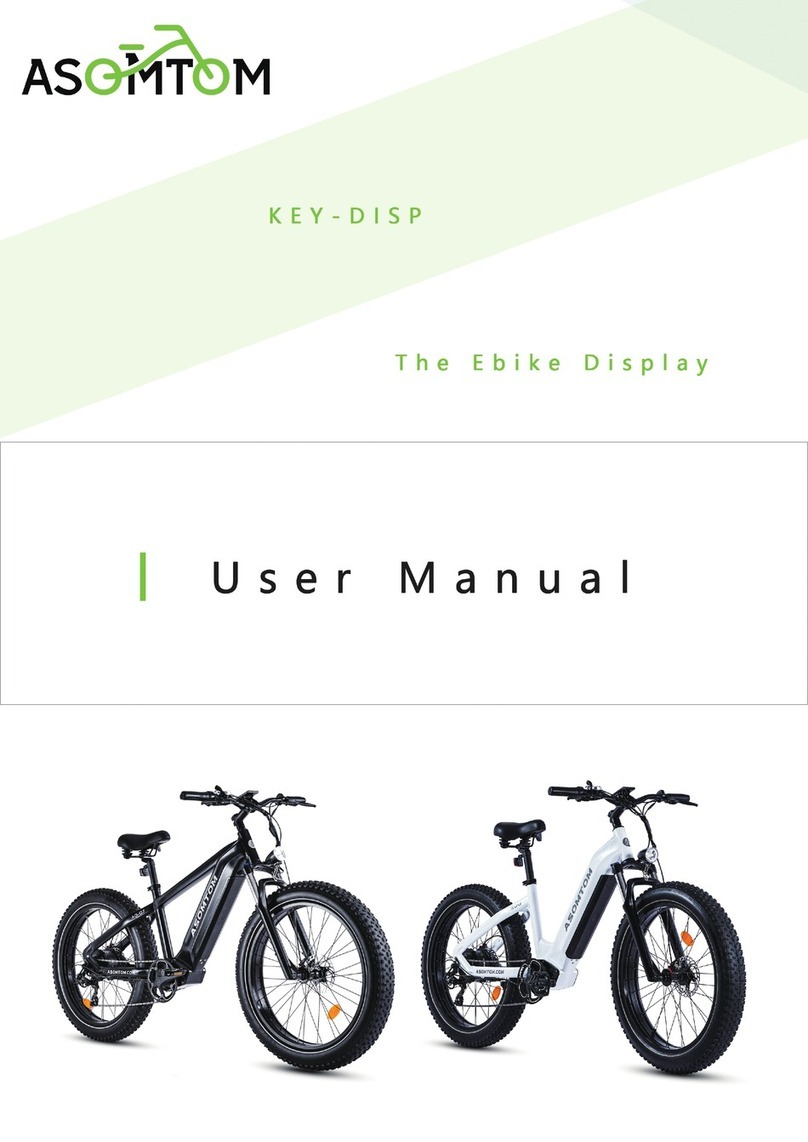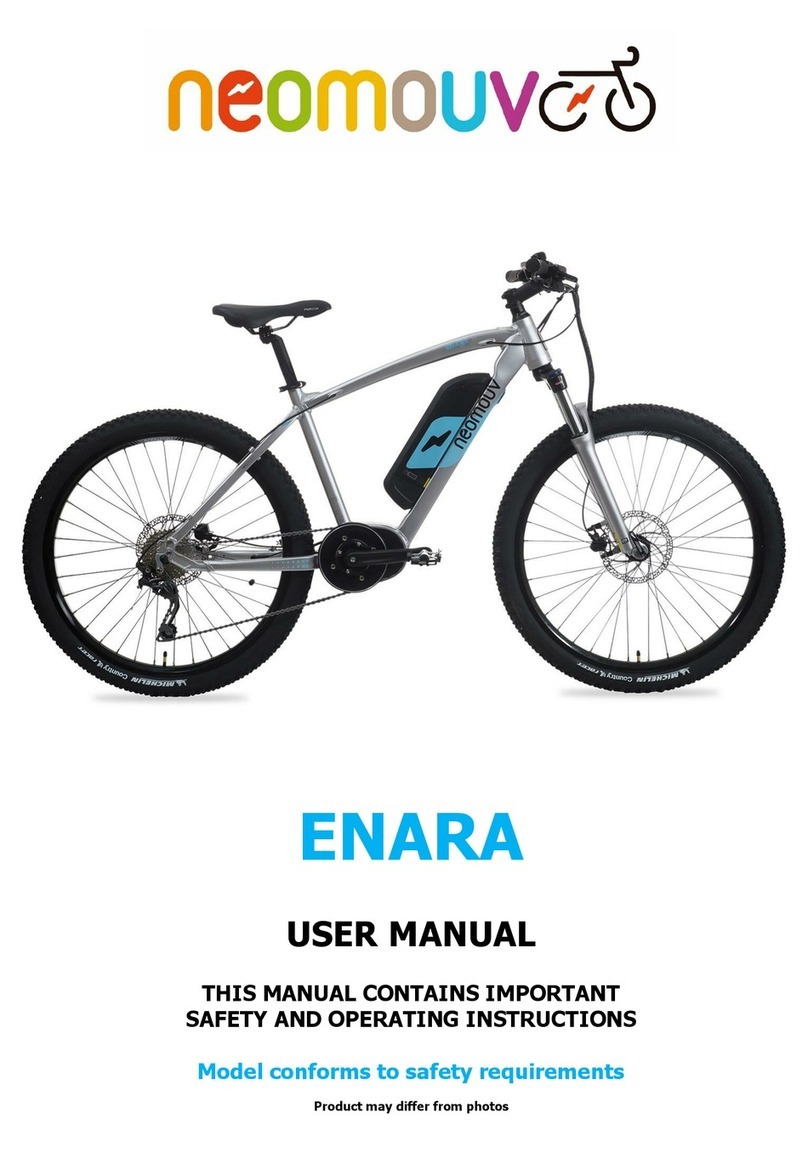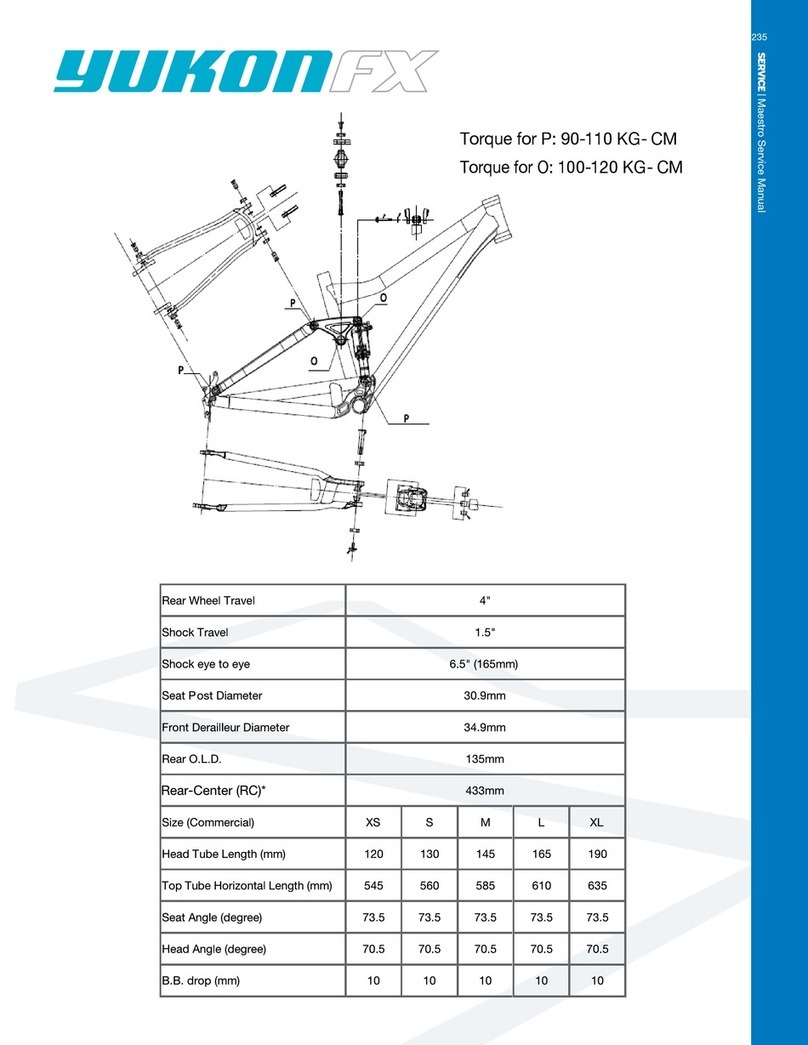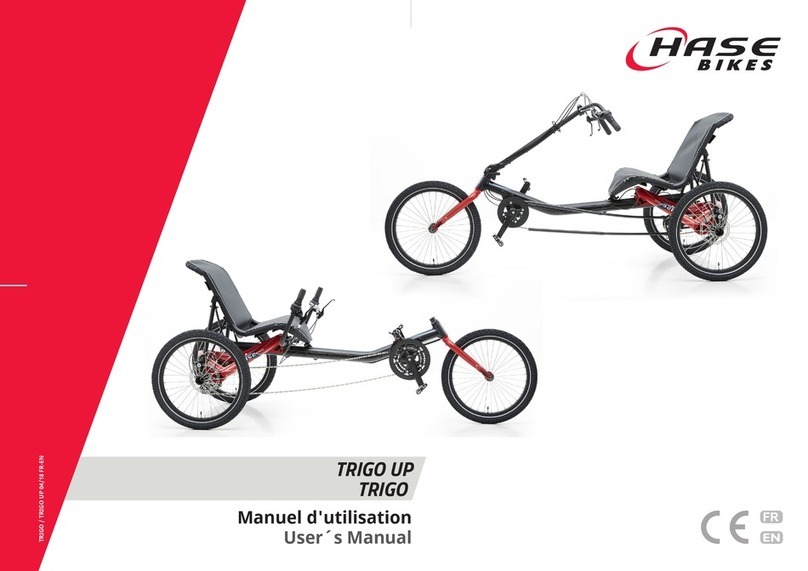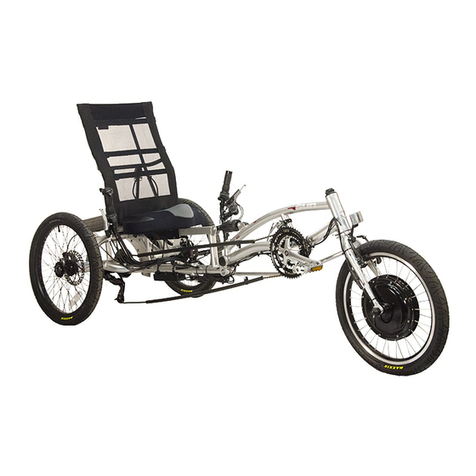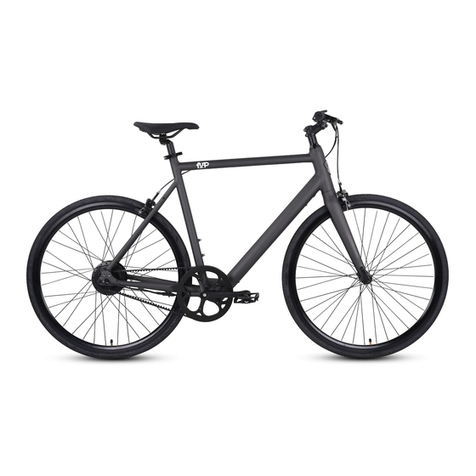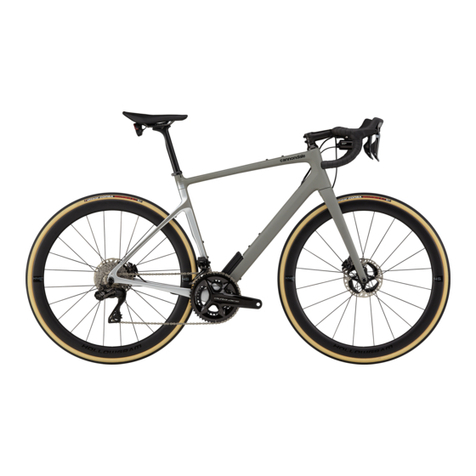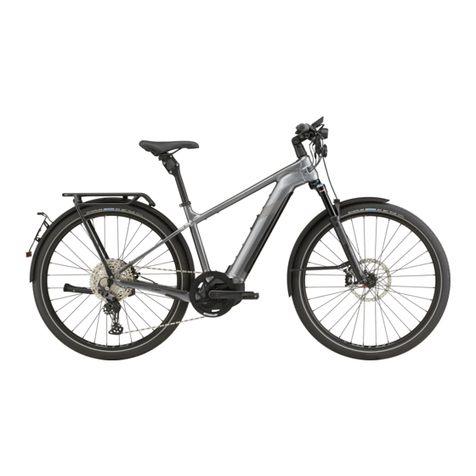BEMOOV M24 User manual

USER’S MANUAL
Bemoov M24
www.bemoov-bikes.be

2
TABLE OF CONTENTS
Your BEMOOV and its components ................................................................................................................................................................................ 03
Assembly instructions ............................................................................................................................................................................................................... 04 - 14
A. Unpacking ................................................................................................................................................................................................................. 04 - 05
B. Adjusting the handlebars .............................................................................................................................................................................. 06 - 07
C. Attaching the front wheel .............................................................................................................................................................................. 08 - 09
D. Connecting the front brake .......................................................................................................................................................................... 10
E. Attaching the pedals ......................................................................................................................................................................................... 11
F. Adjusting the saddle height ......................................................................................................................................................................... 12
G.Positioningthereectors.............................................................................................................................................................................. 13-14
H. Tire pressure ........................................................................................................................................................................................................... 14
Safety instructions and guidelines for use .............................................................................................................................................................. 15 - 16
Servicing and maintenance .................................................................................................................................................................................................. 17 - 19
A. General ........................................................................................................................................................................................................................ 17
B. Frame ............................................................................................................................................................................................................................ 17
C. Brakes .......................................................................................................................................................................................................................... 18
D. Wheels ........................................................................................................................................................................................................................ 19
E. Drivetrain .................................................................................................................................................................................................................... 19
Adjustments and repairs ......................................................................................................................................................................................................... 20
Important technical data ......................................................................................................................................................................................................... 20
Environment ....................................................................................................................................................................................................................................... 20
Limits of liability ............................................................................................................................................................................................................................. 21
Warranty ............................................................................................................................................................................................................................................... 21
This manual contains important instructions regarding the assembly, safety, use and maintenance of your
bicycle.
Before using your bike, we recommend that you read this detailed information as well as view the explana-
tory videos when you visit our website www.bemoov-bikes.be.
If you still have questions or concerns when assembling or using your Bemoov, you can also consult our
FAQs, and if you cannot nd the answer to your question, you can contact our support team via the website
www.bemoov-bikes.be
IMPORTANT
!

3
1 10 20
2 11 21
3 12 22
4 13 23
25
27
5 14
18
24
26
28
6
8
15
19
7
9
16
17
Gear shifter Front brake aluminum bend Frame
Stem cover Front brake arm Fork
Brake lever Brake block Saddle
Stem Derailleur Seat clamp
Quick releases
Rim
Stem spacer Free wheel
Crank
Seatpost
Spoke
Tire
Handlebar
Stem clamp bolt
Chain
Pedal
Stem cap
Steering cup
Chain guard
Bottom bracket
YOUR BEMOOV AND ITS COMPONENT
18 19 20 211513 14
1 2 3
45
12
11
10
16 17
26
28
22
23
24
25
27
8
9
6
7

4
ASSEMBLY INSTRUCTIONS
Your Bemoov bike is delivered to you partially assembled. It is essential that you follow the assembly instructions in this ma-
nual extremely carefully.
A. UNPACKING

5
When the bike is out of the box, carefully remove the pro-
tective coverings and take out the tool box which contains:
- 1 Allen key M2
- 1 Allen key M5 (5mm)
- 1 Allen key M4 (4 mm)
- 1 open-end wrench (15mm)
- 1 white front reector + oset clamp
- 1 red rear reector + right clamp
- 4 orange wheel reectors
- 1 pair of pedals
- 1 front wheel quick release
- 1 user manual
The removal of the protective coverings is very simple. Most detach manually. If you must use scissors or
pliers, avoid scratching the paints.
ATTENTION !
!

6
STEP 1 :
Loosen and detach the stem cover at the 4 bolts.
STEP 2 :
Avoiding crossing the brake and derailleur cables, place the
handlebars on the stem.
STEP 4 :
Gradually retighten the cover bolts in a cross pattern,
following the diagram above and respecting the top and
bottom spaces between the cover and the stem body.
STEP 3 :
Then replace the cover and its 4 bolts. Center the handlebar
by referring to the lines engraved on it.
B. FIXING AND ADJUSTING THE HANDLEBAR:
1 4
23

7
STEP 5 :
Before fully tightening the cover, adjust the angle of the
handlebars so that the brake levers are at 35°.
You can now completely cross-tighten (maximum torque 6
Nm*) the 4 cover bolts.
*Newton meter
Failure to tighten the various stem bolts correctly can lead to serious accidents.
Take the handles with both your hands: Try by rotating the handlebars forwards or backwards to make sure
that they are properly tightened on the stem
No movement should be observed. If there is still movement, tighten the various bolts to reach the maximum
tightening torque of 6 Nm. If in doubt, check the technical information or contact our support team via our
website www.bemoov-bikes.be
ATTENTION !
!
35°

8
STEP 1 :
Detach the elastic to loosen the arms of the front brake
STEP 2 :
Placethefrontwheelbetweentheforkbytting
it on the axle of the front wheel hub. Check the direction of
rotation of the tire which is indicated on the sidewall of the
tire.
C. ATTACHING THE FRONT WHEEL:

9
STEP 3 :
Slide the quick release (QR) into the wheel hub. Check that
the QR lever is on the side opposite the derailleur (see rear
wheel). Slide on one of the two springs before screwing the
nut clockwise. Make sure that during this maneuver, the QR
lever is in the open position.
STEP 4 :
Finish screwing the nut, while closing the SR lever. Then
close it completely by pointing it towards the back of the
bike.
You should feel a clamping pressure when the QR lever is closed. The degree of quick-tightening can be ad-
justed by turning the nut when the lever is open: turn it clockwise to tighten or counter-clockwise to release
the pressure.
Check that the front wheel is correctly installed once the QR is closed. Raise the handlebars and try to move
the front wheel side to side and up and down. If there is no unwanted movement and if the wheel is well cen-
tered in the fork, the wheel is correctly mounted.
ATTENTION !
!
BeforeQuick releases Back

10
STEP 1 :
Reconnect the front brake by hooking the aluminum bend in
its hinge. Check that this matches the rear brake mounting.
STEP 2 :
Pull the left brake lever to check that the brake works
properly. Both brake pads must be in contact with the rim.
D. CONNECTING THE FRONT BRAKE:
Before allowing the child to ride the bike, always check that the brakes are working properly. The brakes are
factory adjusted. However, you can follow our advice on settings on our site if necessary. If in doubt, please
check the technical information or contact our support team via our website bemoovbikes.com.
ATTENTION !
!

11
STEP 1 :
Position the right pedal in front of the right crank arm, the red
R sticker on the crank arm and the one on the pedal must
be identical. Then insert the pedal in the thread and tighten
clockwise until it locks.
STEP 2 :
Position the left pedal in front of the left crank arm, the green
L sticker on the crank arm and the one on the pedal must
be identical. Then insert the pedal in the thread and tighten
counterclockwise until it locks.
E. INSTALLING THE PEDALS
Sticker R red Sricker L green
Make sure you have clearly identied the R and L pedals before screwing them in, otherwise the bolt threads
will be permanently damaged. For best results, we advise you to put a little grease on the thread.
ATTENTION !
!

12
You should feel some clamping pressure when the QR lever is closed. The degree to which the clamp is
tightened can be modied by adjusting the nut when the lever is open: turn it clockwise to tighten or coun-
terclockwise to release.
Never mount the seat post above its maximum allowable height, indicated by an engraving on the seat
post, since this could break the seat post or the seat tube
ATTENTION !
!
F. ADJUSTING THE SADDLE HEIGHT
STEP 1 :
Slightly loosen the seat tube clamp.
STEP 2 :
Adjust the saddle height so that your child can have his/her
feet on the ground when sitting on the saddle and hold that
position steady.
STEP 3 :
Close the quick release.
Limit

13
G. ADJUSTING THE REFLECTORS
STEP 1 :
Placethewhitereectoratthefrontonthehandlebarwith
theosetclamp
STEP 2 :
Placetheredreectoratthebackontheseatpostwiththe
right clamp

14
STEP 3 :
Installtheorangereectorsforthewheels(2Xfrontwheel,2
Xrearwheel)
Fitthegrooveinthecenterofthereectorononeofthe
spokesandlettheleftandrightspokesholdthereector.
For safety: We recommend that you install all the reectors. These are mandatory according to the trac
laws of many countries. Riding with reectors increases the cyclist’s visibility to other road users. Reectors
are designed to capture and reect car lights and headlights as a way to make the bike more visible, but
they do not replace lights. If your child rides at night, the bike must be equipped with lights, as provided for
in the Highway Code. Please check the relevant national legal requirements.
ATTENTION !
!
STEP 4 :
Placethexingnutinthecenterholeofthereector.Screw
it.Atthisstage,thereectorissecure.Itmaystillmoveslight-
lyupanddownaftertighteningthexingnut.
H. TIRE PRESSURE
It is possible that during transport the tire pressure will go down. If necessary, refer to the BAR/PSI pressure indicated on the
sidewall of the tires to adjust this pressure using a bicycle pump.

15
SAFETY INSTRUCTIONS AND GUIDELINES FOR USE
If you are the responsible adult, parent or guardian, we recommend that you read the safety instructions and these instructions
forusebeforethersttimethebikeisridden.
Your Bemoov is delivered to you partially assembled. It is essential that you carefully follow the assembly instructions in this
manual.Youwillalsonddetailedvideosupportonourwebsitewww.bemoov-bikes.be
•Each Bemoov bike is adapted to the weight of the child
of the age corresponding to the model. Please respect
the authorized weight limit:
BEMOOV 20: maximum 45 kg
BEMOOV 24: maximum 55 kg
•Your Bemoov bicycle has been designed to be used on
paved and semi-paved terrain and on smooth gravel or
tarmac. It is not designed for stunts, jumps or any other
extremediscipline(BMX,DIRT,DH,Slalom,Enduro…).
If your child uses their bike beyond its limits, there is a
real risk of failure that could lead to serious injury.
•Always comply with national legal requirements for road
tracorforesttrac.Explaintheserulestoyourchild
before he/she sets out on a road or path.
•If your child rides on the road, make sure that the
bicycle and the cyclist comply with the highway code of
yourcountry:reectors,lighting,bell,helmet,etc.
• Avoidridingonroadsheavilyusedbycartrac.
•Make sure your child always wears a suitable helmet
when riding a bike.
• Makesurethehelmetisproperlyttedaccordingtothe
manufacturer’s instructions.
•Make sure your child wears protective clothing.
•Make sure your child wears sturdy, non-slip shoes.
Check that nothing can get tangled in the pedals or
transmission.
Never ride barefoot
•Make sure your child can get to know the new bike in a
safe environment under your control.
•Make sure your child understands how the brakes on their
bike work. Check if it can stop at all times and safely by using
the brake levers.
•Avoid allowing your child to ride in wet weather and on
slippery ground. Be aware that braking and tire grip
performancewillbesignicantlyreducedinthese
conditions.
•Please ensure that children are aware that bicycles have
moving parts and that they cannot touch them when they
are in motion. Spokes, tires, chain, gears and other
moving parts can cause serious injury if contacted during
movement. This risk exists even if the bicycle is not in
motion.
•Please ensure that your child does not carry passengers
on his/her Bemoov.
•Crashes are sometimes unavoidable when riding a
bicycle. As the bicycle is made up of sharp and hard
metal objects, these crashes can cause injury. After a
fall,rstcheckifthechildisokay.Thencheckthegeneral
condition of the bike and its components before the child
can get back on the bike. If in doubt, please contact our
technical support team via our website www.bemoov-
bikes.be or go to a bicycle shop for a professional
inspection.
• Ridingwithreectorscanincreaseyourchild’svisibility
tootherroadusers.Reectorsaredesignedtocatch
andreectcarheadlightsandotherarticiallightsto
makethebikemorevisible.Reectorsdonotreplace
lights. If your child rides at night, the bike must be
equipped with a front and rear lighting system.
WARNING:Ridingafterdarkwithoutlightsorreectors
is extremely dangerous. Please check your relevant
national legal road requirements.
•Never ride a bike with earphones on.
It is important for the rider to be able to hear what is
happening in the immediate environment (cars, bells,
horns, etc.). Additionally, headphone wires can become
entangled in moving parts of the bike and pose a hazard.
A. GENERAL

16
If someone borrows your child’s bike or if another guardian is supervising your child, make sure they have read
the detailed instructions for using your bike.
ATTENTION !
!
BEFORE EACH USE, make sure that:
•Saddle and handlebars are tight enough.
•Brakes and brake levers work and are properly adjusted.
•The wheels are tightened at the axles, and rotate well.
•The saddle height allows your child to put his/her feet on the ground in order to start or stop easily.
•Thetirepressureissucientandappropriate(seetiresidewallpressure:PSI/BAR).
•Alltheboltsandothercomponentsarewellxedandshownosignsofabnormalwear.
•The frame, rims and tires are not damaged.

17
CARE AND MAINTENANCE
Bemoovbikeshavebeenmanufacturedwithqualitycomponentssothattheyaredurableandecient.Keepingyourbike
clean and maintained will extend its life and function while maintaining your child’s safety. This will also allow the bike to retain
the high resale value which most used Bemoov bikes maintain.
To do this, we have listed some tips and checks:
A. GENERAL INSTRUCTIONS
To clean your bike, we advise you to use hot water, a sponge and a classic degreasing soap. Never use acidic products, or
liquids containing solvents. Check the instructions on these products before using them. Never clean your bike with a high
pressure jet.
Regularly lubricate the moving parts of your bike. Weather conditions are usually the main determinant of maintenance and
lubrication frequency. This maintenance also depends on the frequency, type, and duration of riding.
B. BIKE FRAME
Bemoov frames are made of high quality and very light 6061 aluminum. Frame maintenance is minimal. Cleaning according to
thegeneralinstructionswillsuce.Taketheopportunityeachtimeyoucleanittoinspecttheframecompletelytodetectany
damage.
Underthebottombracket,youwillndengravedonit,aserialnumber.Thisclearlyidentiesyourbike.Thisnumberwillbe
usefulincaseoftheftorforinsurancequestions.Writedownthisserialnumbertokeepinyourles.
Serial number

18
Bemoov brake adjustment and maintenance items:
1
2
4
3
5
6
Brake cable mounting bol
Secure/adjusting bolt for the brake blocks.
Brake lever angle adjusting and clamping bolt
Bolt for adjusting the brake arm
Brake lever stroke adjusting bolt
Brake cable manual tension adjusting bolt
1
2
3
6
5
4
C. THE BRAKES
BemoovhaschoseneasilyadjustableandecientV-Brakebrakes.Brakesareofcourseoneoftheprimaryelementsforsafe
use. Maintenance and upkeep are important. Be certain to check and maintain them regularly.
What should regularly be checked on the brakes:
• Dependingontheuserandhis/herprociencylevel,youwillneedtoadjustthestrokeofthebrakelevertoimprovehow
wellittsyourchild’shands.Tighteningbolt4clockwisebringstheleverclosertothehandlebarsforsmallhands.
•After extended use, you will notice a slight stretching of the brake cable. It will be more and more “soft. Unscrewing bolt 5
anti-clockwise will restore tension to the brakes.
•Regularly check the wear of the brake pads. Never exceed the wear lines. Once the brakes wear beyond the wear lines,
they will have to be replaced.
•Regularly check the angle of the brake lever on the handlebar. The correct angle of 30-35° should allow a straight line
between the rider’s hand and forearm. Adjust this position by tightening bolt 4.
•Be sure not to allow oil or any lubricant to come into contact with the pads or the rim.
• Checkthatthepadstouchtheatfaceoftherimwithouttouchingthetires.Bolt2willallowyoutoreadjustthispositionif
necessary.
• Checkthatthecablexingbolt(2)isstilltight.
•Regularly check that when you lift the bike, the front and rear wheel rotate freely. Be certain to prevent your child from
touching any of the moving parts when you make this test Otherwise, proper readjustment will be required.
(see our website www.bemoov-bikes.be for more information.)

19
Check that your wheels are well centered in the frame and in
the fork.
Always check the wheels are correctly attached to the frame
and the fork. To do this, regularly check that the quick-re-
lease lever is correctly tightened (see point C assembly
instructions.)
Check the wear of the rims of your bike. Our Bemoov bikes
have an embossed black indicator line on the circumference
of the rim. In case of heavy use, they will have to be replaced
when the indentation begins to fade.
E. THE DRIVETRAIN
The drivetrain is comprised of all the components including the chain, the crankset, the pedals and the freewheel.
These components work together to keep your child moving forward. This is why it is crucial to maintain them perfectly.
•Clean: Use a soft bristled brush to remove any dirt or debris attached to the chain and freewheel.
•Degrease: Spray cleaner or degreaser on the chain and freewheel. Then wipe everything with a cloth by turning the crank.
•Lubricate the chain regularly. We recommend lubricating periodically or after excessive use. Apply only bicycle chain lube
tothechainandfreewheel.Thenuseadryclothtowipeoexcesslubricant.
• Thebicyclechainissubjecttostrongforces.Itstensioncanuctuatedependingonitsuse.Thetensionisidealifitdoes
not form too marked a curve (see photo). This tension can be adjusted by moving the rear wheel horizontally.
D. THE WHEELS
Dependingonyourchild’stypeofriding,thewheelsmaysuerdamageordeformation(cracks,warping).Theseissuescan
cause braking and handling problems. Deformed, cracked or broken rims must be adjusted (spoke tension adjustment) or re-
placed. If in doubt, please contact our support team via the website www.bemoov-bikes.be or go to a bicycle shop for profes-
sional service.
Vériezrégulièrementlapressiondespneusetl’usuredeceux-ci(pertenormalede+-1barparmois).Veuillezrespecterles
indicationsdepressionminimumetmaximumquisetrouventsurleancdupneu(PSI/BAR).Leschambresàairontdes
valvesdevoituresetpeuventdoncêtregonéesdanslesstations-service.Remplacezimmédiatementlespneususés.
•The derailleur: Bemoov uses a high-quality, very precise
derailleur controlled by ergonomic shift levers for
children. Our gear selectors are designed with
dierentiatedcolormarkersthatinstinctivelyhelp
childrenmaketherightchoice:Red:+fast,+eort.Green:
- fast,
-eort.
After some time of use, it may be necessary to adjust
your derailleur for smoother shifting. See our image and
video advice on www.bemoov-bikes.be

20
ADJUSTING AND REPLACING PARTS
TohelpyoutoadjustorrepairyourBemoovbikemoreeasily,youwillndexplanatorytutorialsonourwebsite
www.bemoov-bikes.be. Visit us to become an expert bike mechanic for your Bemoov.
IMPORTANT TECHNICAL DATA
Allofthetechnicalspecicationsforeachbikemodelcanbefoundonourwebsitewww.bemoov-bikes.be
To help you with the assembly and maintenance of your Bemoov’s setup, we have provided the tightening torque values
recommended when adjusting or mounting components. It is imperative to respect these values to avoid causing
irreparable damage which may cause accidents while using the bike.
All stem bolts
Bottom bracket clamp bolt
Pedals
Brake lever
Brake cable pinch bolt
Seat clamp
Brake blocks
4-6Nm
40 Nm
35-40 Nm
4-6 Nm
6 Nm
6-8 Nm
8 Nm
Components Tightening force
RESPECT OUR ENVIRONMENT
Bemoov is committed to respecting the environment. We have protected your bike in its box with a maximum of recyclable
elements. Please sort and appropriately dispose of these protective items to the proper recycling receptacles.
For the maintenance of your bike, we advise you to use biodegradable cleaning products.
Our bikes have been designed with quality components to ensure that your bike is durable. If you no longer use your bike, it
will keep its initial value for a long time and it will be easily resold second-hand to make new children happy.
A quality Bemoov bike is not disposable, it is durable!
Table of contents
Other BEMOOV Bicycle manuals

